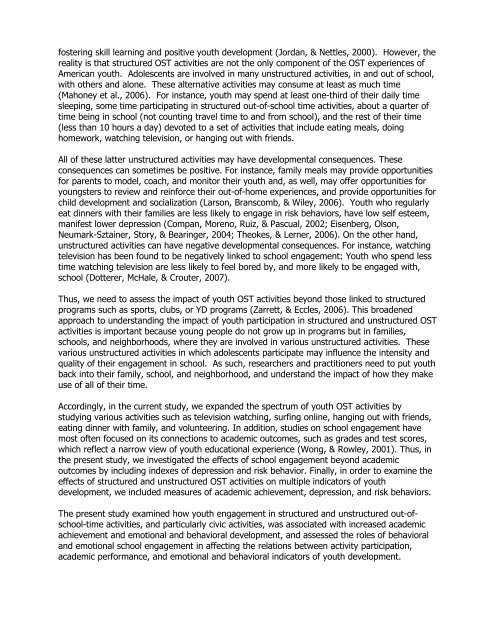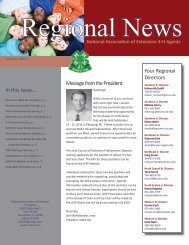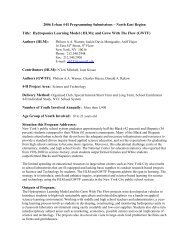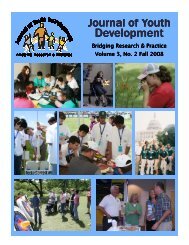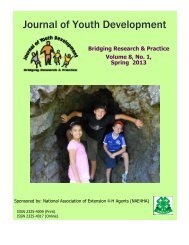fostering skill learning and positive youth development (Jordan, & Nettles, 2000). However, thereality is that structured OST activities are not the only component <strong>of</strong> the OST experiences <strong>of</strong>American youth. Adolescents are involved in many unstructured activities, in and out <strong>of</strong> school,with others and alone. These alternative activities may consume at least as much time(Mahoney et al., 2006). For instance, youth may spend at least one-third <strong>of</strong> their daily timesleeping, some time participating in structured out-<strong>of</strong>-school time activities, about a quarter <strong>of</strong>time being in school (not counting travel time to and from school), and the rest <strong>of</strong> their time(less than 10 hours a day) devoted to a set <strong>of</strong> activities that include eating meals, doinghomework, watching television, or hanging out with friends.All <strong>of</strong> these latter unstructured activities may have developmental consequences. Theseconsequences can sometimes be positive. For instance, family meals may provide opportunitiesfor parents to model, coach, and monitor their youth and, as well, may <strong>of</strong>fer opportunities foryoungsters to review and reinforce their out-<strong>of</strong>-home experiences, and provide opportunities forchild development and socialization (Larson, Branscomb, & Wiley, 2006). Youth who regularlyeat dinners with their families are less likely to engage in risk behaviors, have low self esteem,manifest lower depression (Compan, Moreno, Ruiz, & Pascual, 2002; Eisenberg, Olson,Neumark-Sztainer, Story, & Bearinger, 2004; Theokes, & Lerner, 2006). On the other hand,unstructured activities can have negative developmental consequences. For instance, watchingtelevision has been found to be negatively linked to school engagement: Youth who spend lesstime watching television are less likely to feel bored by, and more likely to be engaged with,school (Dotterer, McHale, & Crouter, 2007).Thus, we need to assess the impact <strong>of</strong> youth OST activities beyond those linked to structuredprograms such as sports, clubs, or YD programs (Zarrett, & Eccles, 2006). This broadenedapproach to understanding the impact <strong>of</strong> youth participation in structured and unstructured OSTactivities is important because young people do not grow up in programs but in families,schools, and neighborhoods, where they are involved in various unstructured activities. Thesevarious unstructured activities in which adolescents participate may influence the intensity andquality <strong>of</strong> their engagement in school. As such, researchers and practitioners need to put youthback into their family, school, and neighborhood, and understand the impact <strong>of</strong> how they makeuse <strong>of</strong> all <strong>of</strong> their time.Accordingly, in the current study, we expanded the spectrum <strong>of</strong> youth OST activities bystudying various activities such as television watching, surfing online, hanging out with friends,eating dinner with family, and volunteering. In addition, studies on school engagement havemost <strong>of</strong>ten focused on its connections to academic outcomes, such as grades and test scores,which reflect a narrow view <strong>of</strong> youth educational experience (Wong, & Rowley, 2001). Thus, inthe present study, we investigated the effects <strong>of</strong> school engagement beyond academicoutcomes by including indexes <strong>of</strong> depression and risk behavior. Finally, in order to examine theeffects <strong>of</strong> structured and unstructured OST activities on multiple indicators <strong>of</strong> youthdevelopment, we included measures <strong>of</strong> academic achievement, depression, and risk behaviors.The present study examined how youth engagement in structured and unstructured out-<strong>of</strong>school-timeactivities, and particularly civic activities, was associated with increased academicachievement and emotional and behavioral development, and assessed the roles <strong>of</strong> behavioraland emotional school engagement in affecting the relations between activity participation,academic performance, and emotional and behavioral indicators <strong>of</strong> youth development.
We expected that:(1) Being engaged with structured and unstructured activities such as family meals,exercising, and civic activities would be positively associated with favorable youthdevelopment, whereas participation in unstructured entertainment activities such ashanging out with friends and media use (TV watching, playing video games) would benegatively associated with positive indicators <strong>of</strong> youth development; that(2) youth, through participating in civic activities (i.e., helping, volunteering, and tutoring),would benefit themselves in terms <strong>of</strong> academic achievement and other indicators <strong>of</strong>development; and that(3) school engagement could be promoted through out-<strong>of</strong>-school time activities and wouldbe predictive <strong>of</strong> academic achievement and other aspects <strong>of</strong> positive youthdevelopment.MethodThe present study was conducted as a part <strong>of</strong> the 4-H Study <strong>of</strong> Positive Youth Development(PYD), which is a multi-wave longitudinal investigation in the United States that started in 2002by assessing 5th grade youth and their parents. This report presents data derived from aStudent Questionnaire (SQ) administrated during the fourth wave <strong>of</strong> the 4-H Study, i.e., duringeighth grade. Full details <strong>of</strong> the methodology <strong>of</strong> the 4-H study have been presented in priorreports (Jelicic, Bobek, Phelps, Lerner, & Lerner, 2007; Lerner, et al., 2005). Accordingly, wepresent here those features <strong>of</strong> methodology pertinent to the focus <strong>of</strong> this investigation.ParticipantsThe present paper is based on Grade 8 participants in the 4-H study who were sampled from 24states across the nation. This sample is comprised <strong>of</strong> a cross-sectional group <strong>of</strong> 1,567adolescents (62.0% female). The mean age <strong>of</strong> youth in this sample was 14.21 years (SD = 0.76Years). Socioeconomic status (SES) is indexed as family income (M = $63,683, SD = $36,092)and mother’s education (M = 14.21 years, SD = 0.76 years). In the current study we controlledfor sex and mother’s education in all analyses reported. The sample was largely EuropeanAmerican (71.0%), but included 8.8% Latino/a American, 8.4% African American, 3.0% AsianAmerican, 2.0% Native American, and 3.6% multi-ethnic/racial American youth.MeasuresThere were many standard demographic questions about youth and their families (date <strong>of</strong> birth,sex, race/ethnicity, and so forth). In addition to the demographic measures, the present studyused measures <strong>of</strong> the assessment <strong>of</strong> the behavioral and emotional school engagement, youth’sparticipation in out-<strong>of</strong>-school time activities, grades, depression, and risk behaviors. All <strong>of</strong> thenon-demographic measures employed in this paper come from the Student Questionnaire (SQ).Participation in Out-<strong>of</strong>-School Time Activities. Youth participation in out-<strong>of</strong>-school timeactivities was assessed by questions pertaining to 19 activities (see Table 1). We categorizedthese out-<strong>of</strong>-school time activities into six types for the analyses: Youth Development (YD)programs, civic activities, exercise, hanging out with friends, family dinner, and passive mediause (see Table 1). Items indicate whether the student participates in specific activities (e.g.,watching television or volunteering) or programs <strong>of</strong>fered by youth development organizations inthe current year and whether he or she was involved in these activities or programs in the past.Frequency <strong>of</strong> participation in these activities is also measured (0= never to 5 = every day).
- Page 2 and 3: Winter 2008Volume 3 Number 3Editor
- Page 5: Examining the Potential Unintended
- Page 8 and 9: centered, multidisciplinary approac
- Page 10 and 11: Volume 3, Number 3, Winter 2008Arti
- Page 14 and 15: Table 1Participation in out-of-scho
- Page 16 and 17: ResultsOur analyses were conducted
- Page 18 and 19: watching TV, playing video games or
- Page 20 and 21: Accordingly, this research augments
- Page 22 and 23: Dotterer, A.M., McHale, S.M., & Cro
- Page 24 and 25: A Descriptive View of the 4-H Club
- Page 26 and 27: In this paper, the results of a cro
- Page 28 and 29: section is a set of statements that
- Page 30 and 31: Table 3Experience in the 4-H clubNo
- Page 32 and 33: significantly higher than Caucasian
- Page 34 and 35: p
- Page 36 and 37: This study focused only on the 4-H
- Page 38 and 39: Theokas, C., Lerner, J.V., Phelps,
- Page 40 and 41: Volume 3, Number 3, Winter 2008Arti
- Page 42 and 43: potential for reaching audiences, d
- Page 44 and 45: Putting Marketing Concepts into Pra
- Page 46 and 47: 2. Find out what others think about
- Page 48 and 49: Diem, K.G. (1994). What do youth li
- Page 50 and 51: Promoting Supportive Relationships
- Page 52 and 53: focused on youth-adult relationship
- Page 54 and 55: Conversely, more modern educational
- Page 56 and 57: perhaps most importantly, the effic
- Page 58 and 59: Organized youth programs, when stru
- Page 60 and 61: likely to internalize the positive
- Page 62 and 63:
Ellis, J.M., & Caldwell, L.L. (2005
- Page 64 and 65:
Schweinle, A., Meyer, D.K., & Turne
- Page 66 and 67:
Volume 3, Number 3, Winter 2008Arti
- Page 68 and 69:
This study uses the “5 Cs” mode
- Page 70 and 71:
ResultsIn this analysis 48 codes we
- Page 72 and 73:
Table 3Inductive Codes Classified b
- Page 74 and 75:
CompetenceCompetence in organized s
- Page 76 and 77:
ecause of him (the coach)…. You d
- Page 78 and 79:
practices and competitions, the gir
- Page 80 and 81:
Eccles, J.S., & Gootmann, J.A. (Eds
- Page 82 and 83:
Smoll, F.L., & Smith, R.E. (2002).
- Page 84 and 85:
Volume 3, Number 3, Winter 2008Arti
- Page 86 and 87:
The present work builds upon that o
- Page 88 and 89:
MethodSample and Data CollectionAs
- Page 90 and 91:
(scores ranging from 0 to 8) and a
- Page 92 and 93:
Table 2Paired Sample T-tests Compar
- Page 94 and 95:
Hypotheses 5 and 6 were tested by c
- Page 96 and 97:
De Coverly Veale, D.M.W. (1987). Ex
- Page 98 and 99:
Story, M., Neumark-Sztainer, D., Sh
- Page 100 and 101:
Volume 3, Number 3, Winter 2008Arti
- Page 102 and 103:
Cronbach’s Alpha Score For Youth
- Page 104 and 105:
12 to 18 years old. Fourteen of the
- Page 106 and 107:
Therefore, there was a mixed relati
- Page 108 and 109:
Youth respondents identified two ob
- Page 110 and 111:
are developed through working in a
- Page 112 and 113:
Seevers, B.S., & Dormody, T.J. (199
- Page 114 and 115:
Volume 3, Number 3, Winter 2008Arti
- Page 116 and 117:
With the many opportunities that yo
- Page 118 and 119:
meaningfully reduced involving dedu
- Page 120 and 121:
StaffingXTime/Schedule X X XTrainin
- Page 122 and 123:
“Involving adults that will allow
- Page 124 and 125:
“They can't drive or do not have
- Page 126 and 127:
page in understanding why youth voi
- Page 128 and 129:
Parker, L. (1999). If all youth ser
- Page 130 and 131:
Volume 3, Number 3, Winter 2008Arti
- Page 132 and 133:
However, the literature is mixed in
- Page 134 and 135:
group was the quality of the progra
- Page 136 and 137:
Table 1Reasons for Non-Attendance:
- Page 138 and 139:
easons given was six. Sixty-three p
- Page 140 and 141:
The non-family-related activities t
- Page 142 and 143:
“Catch ‘Em Being Good:”An Ext
- Page 144 and 145:
In 2001, the WVUES received a schoo
- Page 146 and 147:
to leverage the resources of the co
- Page 148 and 149:
4. Most primary behavior incidents
- Page 150 and 151:
Recommendations for developing prog
- Page 152 and 153:
Cross-Cultural UnderstandingThrough
- Page 154 and 155:
that plague these nations such as p
- Page 156 and 157:
2003). Youth leadership training in
- Page 158 and 159:
• enable these young people to pa
- Page 160 and 161:
We believe that the USPORT program
- Page 162 and 163:
West Virginia’s Response to theRo
- Page 164 and 165:
Ensuring good oral health requires
- Page 166 and 167:
Table 1Correlations between Planner
- Page 168 and 169:
problems in this rural state…This
- Page 170 and 171:
Volume 3, Number 3, Winter 2008Arti
- Page 172 and 173:
vacuum. Determination of factors, a
- Page 174 and 175:
ReferencesBaldwin, C., & Caldwell,
- Page 176 and 177:
Volume 3, Number 3, Winter 2008Arti
- Page 178 and 179:
Purpose of StudyThe purpose of this
- Page 180 and 181:
Students in the High computer gamin
- Page 182 and 183:
Do Higher Levels of 4-H LeadershipA
- Page 184 and 185:
IntroductionEmotional Intelligence
- Page 186 and 187:
second section examined demographic
- Page 188 and 189:
a constructive manner. The group is
- Page 190 and 191:
differences in the scores for the 1
- Page 192 and 193:
Adaptability include “Reality Tes
- Page 194 and 195:
ReferencesAmerican Academy of Pedia
- Page 196 and 197:
Healthy Kids, Healthy Families:A Co
- Page 198 and 199:
and a half million U.S. youth (ages
- Page 200 and 201:
Families. In partnering counties, p
- Page 202 and 203:
Healthy Families was then offered a
- Page 204 and 205:
Kamberelis, G., & Dimitriadis, G. (
- Page 206 and 207:
Volume 3, Number 3, Winter 2008Arti
- Page 208 and 209:
Change It Up!What Girls Say About R
- Page 210:
In addition, the study summarizes t


